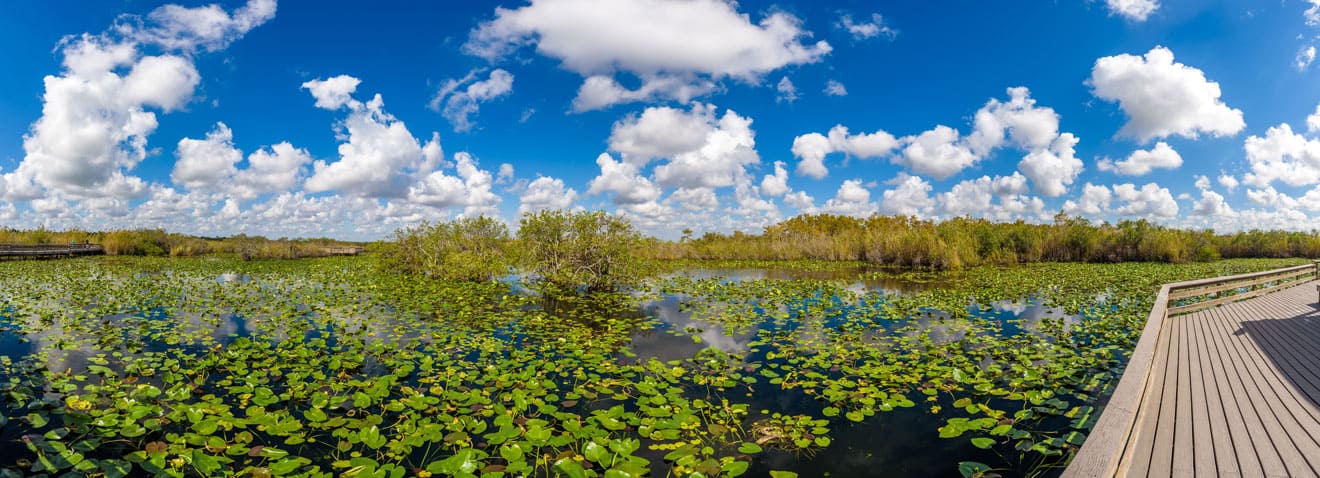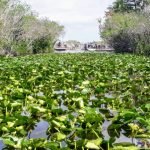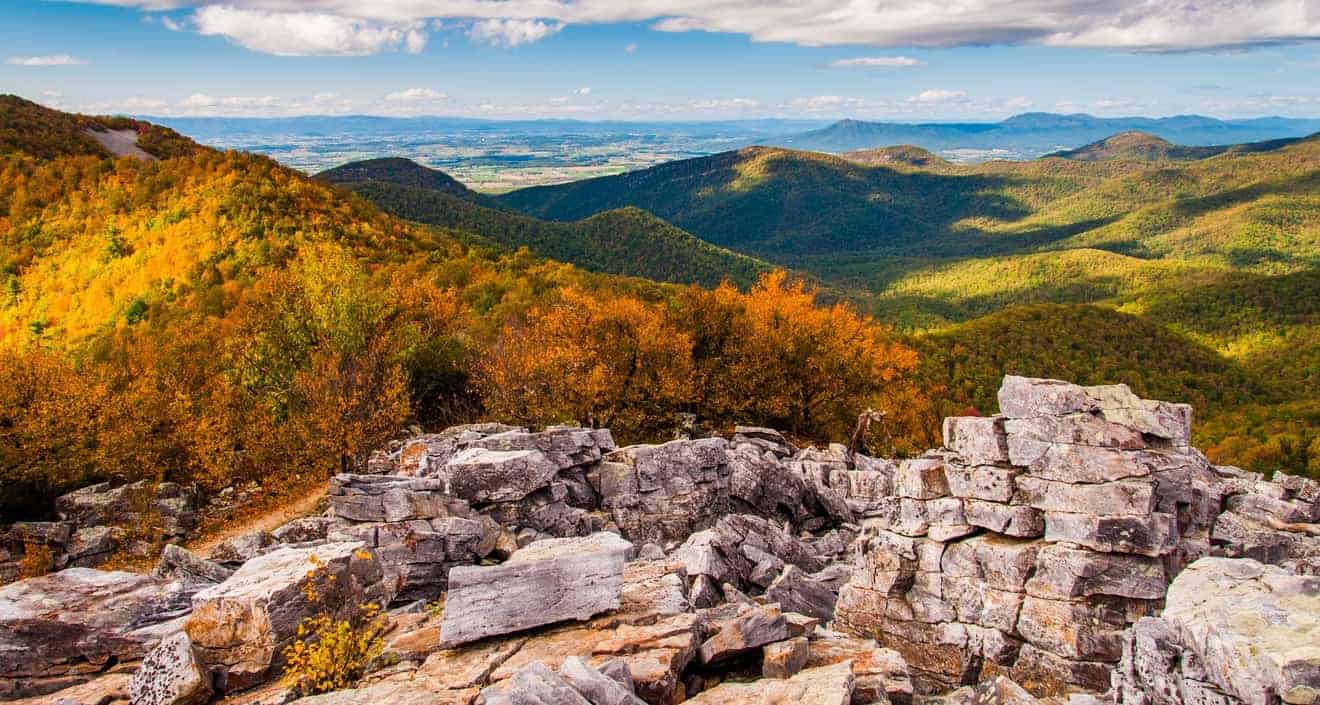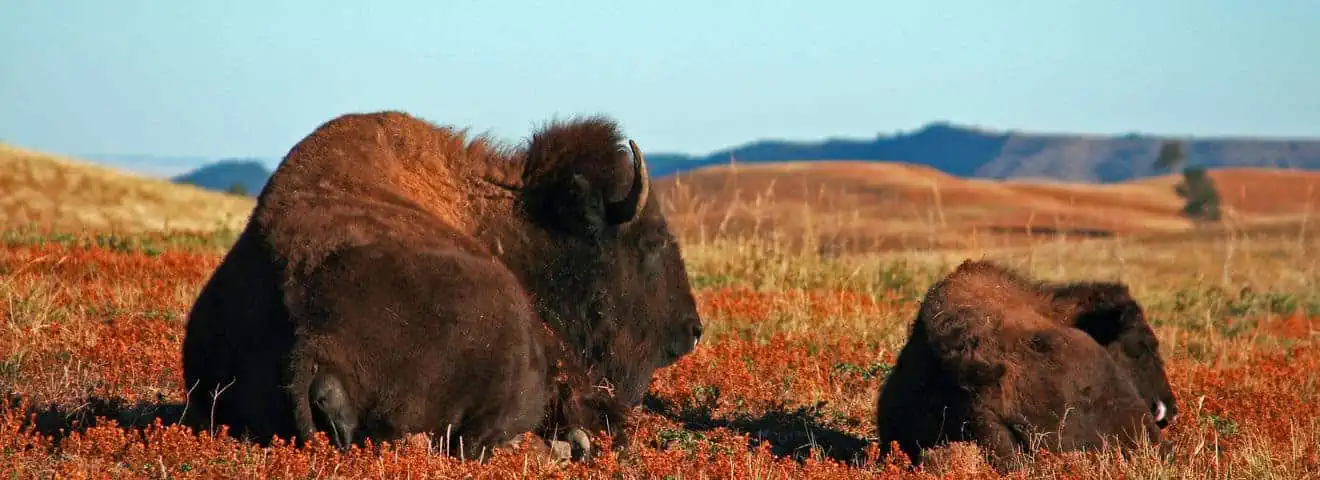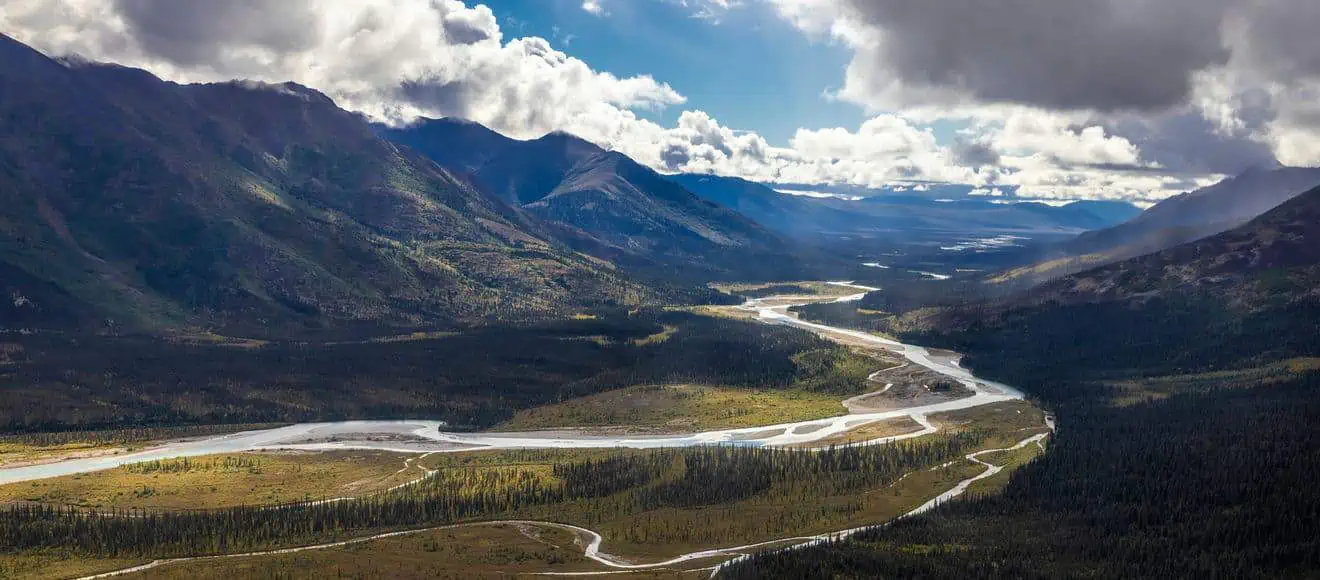If you think you’ve got the spirit of a fearless, romantic explorer inside you, capable of taking on dense swarms of mosquitoes aboard an airboat slicing through the brackish waters of an alligator-infested, hawk-invaded channel, Everglades National Park – located in South Florida’s humid subtropical climes – is for you.
In this article I’ll give you some tips on how to visit Everglades on your own, coming from Miami or other parts of South Florida. I’ll also give you an overview of the different areas of this endless park, giving you advice on the best things to do in the Everglades, including activities and trails. Lastly I’d like to give you some precautionary suggestions on how to take on Everglades excursions, focusing on the best period to visit and the best areas to stay in the surroundings.
If, on the other hand, you don’t have such an adventurous spirit and don’t feel like doing the visit on your own, I will tell you how you can use a guided tour from Miami to explore the park without having to worry about anything in particular.
Contents
What to expect from Everglades: flora and fauna
If you’ve already visited a few American national parks in the West (or on the East Coast) and you think you’ve already got a pretty good idea of the nation’s naturalistic picture, you should know that Everglades will be an absolute novelty for you. There’s nothing like the Everglades in the USA: the national park in question is in fact part of the largest subtropical nature reserve (or eco-region) in the entire United States.
There are no canyons here, no mountains, no sheer cliffs, no deserts, but an ecosystem characterized by flat expanses of sawgrass as far as the eye can see with channels and marshes on the surface of which hammocks of mangroves, forests of willows, Florida pines, dwarf cypresses, palms and palmettos, oaks invaded by climbing ferns, gumbo limbo and many other native and non-native tree species all grow.
Alligators and crocodiles, the tenants of the animal kingdom for which the park is famous, proliferate in this habitat. But they are certainly not the only ones: the delicate ecosystem of Everglades National Park is home to many fish, reptiles (snakes, turtles, iguanas), mammals (Florida panthers, river otters, manatees, swamp rabbits, bobcats, etc.), and birds (storks, ibis, pelicans, herons, herring, ospreys).
In particular, Everglades is really a paradise for birdwatching, but even the less experienced can see unusual birds just about everywhere. The most annoying thing, however, are the mosquitoes, which, however, can be avoided at times of year when the climate is less humid.
Timetables, prices and useful info
The entrance ticket to Everglades is $35 per vehicle, you can also use the America the Beautiful parks card. Tickets can be purchased at the Homestead Entrance, the Shark Valley Entrance, or online on this website. Park entry times differ depending on which entrance you will be using:
- Homestead: the main entrance from where you can visit the Royal Palm and Flamingo area, is open 24 hours a day every day of the year.
- Shark Valley: this area provides easy access to the Shark Valley Area and is open daily from 8:00 am to 6:00 pm. Although the park remains open all day, vehicles will no longer be allowed access after these hours.
- Everglades City – Naples Entrance: This is the gateway to the Gulf Coast Area and is open 24 hours a day. If you only visit this area, you will not need to pay an entrance fee.
Best Time to Visit the Everglades
The best time to visit Everglades National Park is the so-called dry season, which begins in late October and extends through April. In this period, which is opposed to the summer rainy season, the flood waters from summer rains flow towards the sea and it is easier to organize a tour of Everglades to see the wildlife: the alligators are quietly soaking in the gator holes or on the edge of the channels, and tend to be harmless (provided that you do not go tease them!).
Although it is quite hot, the climate is milder and less humid and the mosquitoes are less annoying: I don’t want to exaggerate, but when I went in mid-March I don’t think I saw a single one! In the summer, Everglades is more uncomfortable to visit for the opposite reasons: it rains a lot, the weather is humid, mosquitoes proliferate in the flooded marshes, and the heat is scorching.
How to get to the Everglades
There are 5 visitor centers in Everglades, located in various parts of the park and quite a distance from each other.
- On the south side, near Homestead and Florida City, there are 3: Ernest Coe Visitor Center (40001 State Highway 9336), Royal Palm Visitor Center and Flamingo Visitor Center. The latter is located right on the water, at the end of 9336: a fishing community once lived in this area.
- US 41 is the road that cuts the Everglades reserve in half from east to west. This road, along which there are many airboat tour agencies, theme parks and an Indian village, is called the Tamiami Trail and starts right in the heart of Little Havana in Miami. The landmark on US 41 is the Shark Valley Visitor Center (36000 Southwest 8th Street).
- In Everglades City, on the western side of the park, the Gulf Coast Visitor Center (815 Oyster Bar Lane. Everglades City) can be found. From here, water tours head out to Ten-Thousand Island, an area of the park distinctive for its robust mangrove hammocks. Otherwise, this is not the most popular Visitor Center, but it can be useful for those coming from the West Coast (Naples) and want to get to know the park by taking a water tour.
How to visit the Everglades from Miami
Since the distances are quite short, it is not uncommon for a visit to Everglades from Miami to be interpreted as a day trip with an overnight stay in the city. Of course, in this case you will only get a small taste of the park, but it is the ideal solution for those who do not have much time available.
The distance from Miami to the Ernest Coe Visitor Center and to Shark Valley Center is almost the same (about 40 miles, or a little less than an hour’s drive), so the choice must be made according to the trails and excursions you would like to go on (the reference is to the following paragraphs). If you want to enter the park from both entrances, you should leave Miami very early and organize the day’s schedule as best you can in both areas of Everglades, bearing in mind that some traffic is to be expected both on the road and at the park entrances. To ensure that the day doesn’t become too grueling, my advice is to focus on just one area of the park.
If, on the other hand, Everglades is just a stopover to other destinations, choosing which area of the park to visit is not so arbitrary:
- if you are going from Miami to the Keys and you are not interested in taking an airboat tour, our advice is to go south, entering through the Ernest Coe Visitor Center. This is the most logical choice from a strategic point of view, given a continuation of the trip south on US-1 S.
- If, on the other hand, you’re coming from Miami but want to go on an airboat tour – since the most famous and reliable concession agencies are on US 41 – then it makes sense to enter the park from the Shark Valley Visitor Center and then head back to the Keys in the afternoon along US-41 and US-1 S.
- if you’re going from Miami to Naples, I recommend either the Shark Valley Visitor Center or the Gulf Coast Visitor Center, both of which are conveniently located along the road. Beware though, there are fewer classic hiking opportunities in the southern area.
Can you avoid the toll road to get from Miami to Everglades?
It is not mandatory to take the highway. The quickest way is to use the Ronald Reagan Turnpike to Florida City, but if you want to avoid the toll, you can drive the entire US-1 S without ever taking the highway: it will only take you about 20 minutes longer.
Things to Do in the Everglades
As I anticipated, although the “environmental” characteristics of the park are quite homogeneous throughout the Everglades National Park, the various visitor centers offer quite different activities and excursions. Here’s what to see and do in the various areas of the park:
The Southern Area
The southern area of Everglades is the best choice for those who want to get in touch with Everglades nature through hiking . According to some, this is the area of the park where you can have the most complete experience of the park from a nature perspective. The two main areas are Pine Islands and Flamingo.
Pine Islands
After passing the Ernest Coe Visitor Center, it is best to turn off State Hwy 9336 to the left after 2.5 miles, to reach the nearby Royal Palm Visitor Center. Two famous and significant Everglades trails branch off from here:
- to the left of the Visitor Center is the Anhinga Trail: this famous, simple trail takes its name from a bird you’ll often see perched with open wings in the park’s trees. Walking along the elevated wooden walkway for the entire 0.75 miles of the trail, you have the opportunity to see the typical sawgrass marsh and – among the foliage and at the water’s edge – many protagonists of the local wildlife.
- to the right, instead, you can take the Gumbo Limbo Trail, which is shorter than the previous one (2000 feet in total) but offers a different landscape. In fact, you walk on a path that crosses a dense hammock of gumbo limbo trees, royal palms, ferns and other plants areas.
If you are much more attracted to the latter of these two trails, but would feel more comfortable walking on a boardwalk, I highly recommend you also hit up the Mahogany Hammock Trail . The latter also traverses a dense, shady subtropical forest, but the half mile of the trail is on an elevated wooden platform similar to the Anhinga Trail. Reaching the trailhead requires turning back onto Hwy 9336 and driving toward the Flamingo area for about 18 miles. The detour on the right is well signposted.
Finally you can climb up to the observation platform known as the Pahayokee Overlook, which allows you to see the so-called river of grass for miles. If you like the idea of seeing the view from an elevated point, however, I would recommend heading up to the Shark Valley Observation Tower. The Pahayokee Overlook is located 22 miles past the Ernest Coe Visitor Center.
Flamingo
The Flamingo Visitor Center (with an adjoining Marina Store for those who want refreshments) is located at the end of Hwy 9336 and can be reached if you have more time and want to explore more of the southern Everglades.
Being more exposed to the ocean, this area has been repeatedly damaged by hurricanes that are frequent in the area, so it is likely that you will find trails open, but not maintained: inform yourself in advance on the official website or ask the rangers before embarking on excursions that could be dangerous or harmful to the natural habitat.
If you are fascinated by birds, here in Flamingo you can walk the short Eco Pond Trail, a loop particularly recommended for birdwatching: among the oaks, bushes and sawgrass of this marsh, herring, flamingos, American storks, double-crested cormorants, ibises, macaws, cranes and birds of prey fly at the water’s edge. Far less pleasant, however, are the mosquitoes that are in abundance here, especially in summer.
The Shark Valley Visitor Center Area
Shark Valley is an area of the park crossed by a 15-mile long road that can be done on foot (not recommended because of the heat and the length, but I saw quite a few people doing it!), by bicycle or by streetcar. Halfway down the road there is a very short trail that leads to an observation tower located above a small canal where alligators swim. From the top of this beautiful structure there is a great view of the Everglades’ endless river of grass.
- Bike can be rented on site, directly at the Visitor Center. You should consider 2 or 3 hours, as you will make frequent stops to observe the view or photograph the animals. If you like cycling, this is the most fascinating way to explore Shark Valley: however, do not underestimate the length of the route and the environmental conditions, especially in summer, so bring sunscreen and a mosquito spray. If you want to take off the longest stretch of road before you get to the tower, walk the east side of the loop first (about 1.2 miles longer than the west side).
- The streetcar tour is operated by Shark Valley Tram Tour, lasts 2 hours and is not included in the park entrance fee. The price of the tour (which can be purchased at this link, where departure times are also available) is $31 for adults ages 13-16, $24 for people over 62, and $16 for children ages 3-12. The streetcar departs from the visitor center.
There are a couple of shorter trails that can be hiked:
- the Bobcat Boardwalk Trail: a wooden platform that winds through the crags for about half a mile. The trailhead is 150 feet from the visitor center, right on Shark Valley Loop Road.
- the Otter Cave Hammock Trail is 1300 feet long and allows you to branch off from the main road (which in the long run is a bit monotonous) for a short stretch in the thick of the forest, without the wooden platform. Access to the trail is on the west side of the loop.
Miccosukee Indian Village
If you decide to continue along the Tamiami Trail for just one mile, you will have the opportunity to visit the Miccosukee Indian Village, which is often heavily traveled by tour operators departing from Miami. This place gives you the opportunity to learn about the history and traditions of this Miccosukee Indian tribe, which became independent from the Seminoles in the last century.
The village also offers airboat tours and questionable shows with alligators, but the most interesting part is the reconstructed Indian village, where you can buy authentic artifacts and see the typical costumes of the natives intent in their traditional activities and rituals.
Everglades City area
From Everglades City, and more precisely in the vicinity of the Gulf Coast Visitor Center, boat tours depart to Ten Thousand Islands, an aquatic labyrinth of mangrove islets that extends from the western side of the park to Flamingo. This area can only be visited by boat, canoe or kayak tours, which can be booked on the official website or at this link. There are also numerous airboat tours in Everglades City, but they are not among the licensees authorized to operate within the boundaries of the national park.
The historic Smallwood Store, a small museum of local history housed in a wooden building that rests on stilts, is also worthy of note: here, among other things, you can learn about the history of the mysterious Florida natives called Calusa, who are said to have built artificial islands made of shells. This local history museum is located on the southern tip of Chokoloskee Island, an island that can be reached from Everglades City via an overpass.
Everglades Airboat Tours… and More
One of the most popular activities in the Everglades is taking an airboat tour, a very special boat that sails at high speed on the water in the park’s channels, giving an opportunity to observe the flora and fauna of the place from a different perspective.
The guides slow down the airboat in the most interesting places and explain the most important aspects of the Everglades ecosystem in great detail. Airboats are a bit noisy (you’ll be given earplugs), but the swamp animals will have gotten used to it, despite themselves!
There are only three tour operators officially licensed to provide airboat tours in the Everglades. They are all located on the first section of the Tamiami Trail (US 41, also called SW 8th St), before the Shark Valley Visitor Center.
All have gift shops and restaurants (you can even sample alligator) and offer crocodile shows, instructional demonstrations and other themed attractions. Coopertown (22700 Southwest 8th St) is the first one you’ll encounter coming from Miami: it’s the oldest in the area, but Gator Park (24050 Southwest 8th St) and Everglades Safari Park (26700 Southwest 8th St) are also noteworthy, and you can buy discounted tickets here.
Those of you who don’t feel like visiting the Everglades on your own, or maybe don’t have the time, can take advantage of one of the many Everglades tours and packages departing from Miami.
Everglades Tours from Miami
The classic airboat tour is the most economical of all: it includes transportation from your hotel in Miami to Everglades Park, the airboat tour and a close encounter with alligators and other animals typical of the area. The total duration of the tour varies from 4.30 to 5 hours and is a good solution for those who are in Miami, have little time and do not have a car (or rental car). Check out the links below, as there may be discounts and deals at any time of year.
- Airboat Tour and Transportation from Miami (Getyourguide)
- Open Airboat Tour with Transportation from Miami (Expedia)
- Everglades Airboat Adventure with Transport from Miami (Viator)
There is a package at a very attractive price, that includes – in addition to the airboat tour and the wildlife encounter – a tour of the city of Miami and a cruise of Biscayne Bay, the ideal solution to see the skyline and the luxury homes overlooking the ocean from the water.
- Miami Combo Tour: airboat, Biscayne Bay cruise and Miami coach tour – duration 9 hours (Viator)
Places to Stay Near Everglades National Park
Inside the park there are no facilities for overnight stays, except two campsites (Long Pine Key and Flamingo). The nearest towns to Everglades where you can find accommodation are Homestead and Florida City to the east and Everglades City to the west: the choice is always dictated by the area you wish to visit and especially by your next destination. For example, if you are going to Key West or to one of the Middle Keys, the ideal solution after visiting the park could be Key Largo.
Obviously, as already mentioned, if you take a day trip from Miami or Naples you won’t have to worry. Below you will find some tips on how to choose accommodation in Miami and Naples.
Below, find a list of hotels near the park.
Find a hotel in the Everglades area
